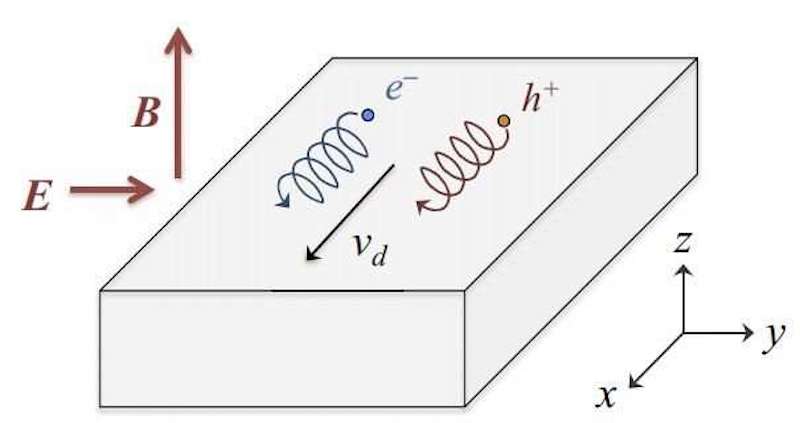 Schematic depiction of the E × B drift of carriers in a strong magnetic field. Electrons (labeled e−) and holes (labeled h+) drift in the same direction under the influence of crossed electric and magnetic fields. Both signs of carrier contribute additively to the heat current in the x direction and subtractively to the electric current in the x direction, which leads to a large Peltier heat Pxx and therefore to a large thermopower Sxx. Credit: Science Advances (2018). advances.sciencemag.org/content/4/5/eaat2621
Schematic depiction of the E × B drift of carriers in a strong magnetic field. Electrons (labeled e−) and holes (labeled h+) drift in the same direction under the influence of crossed electric and magnetic fields. Both signs of carrier contribute additively to the heat current in the x direction and subtractively to the electric current in the x direction, which leads to a large Peltier heat Pxx and therefore to a large thermopower Sxx. Credit: Science Advances (2018). advances.sciencemag.org/content/4/5/eaat2621
May 25, 2018 (Phys.org) -- Imagine being able to power your car partly from the heat that its engine gives off. Or what if you could get a portion of your home's electricity from the heat that a power plant emits? Such energy-efficient scenarios may one day be possible with improvements in thermoelectric materials -- which spontaneously produce electricity when one side of the material is heated.
Over the last 60 years or so, scientists have studied a number of materials to characterize their thermoelectric potential, or the efficiency with which they convert heat to power. But to date, most of these materials have yielded efficiencies that are too low for any widespread practical use.
MIT physicists have now found a way to significantly boost thermoelectricity's potential with a theoretical method that they report today in Science Advances. The material they model with this method is five times more efficient, and could potentially generate twice the amount of energy, as the best thermoelectric materials that exist today.
"If everything works out to our wildest dreams, then suddenly, a lot of things that right now are too inefficient to do will become more efficient," says lead author Brian Skinner, a postdoc in MIT's Research Laboratory of Electronics. "You might see in people's cars little thermoelectric recoverers that take that waste heat your car engine is putting off, and use it to recharge the battery. Or these devices may be put around power plants so that heat that was formerly wasted by your nuclear reactor or coal power plant now gets recovered and put into the electric grid."
Skinner's co-author on the paper is Liang Fu, the Sarah W. Biedenharn Career Development Associate Professor of Physics at MIT.
(more)
READ MORE: Phys.org





